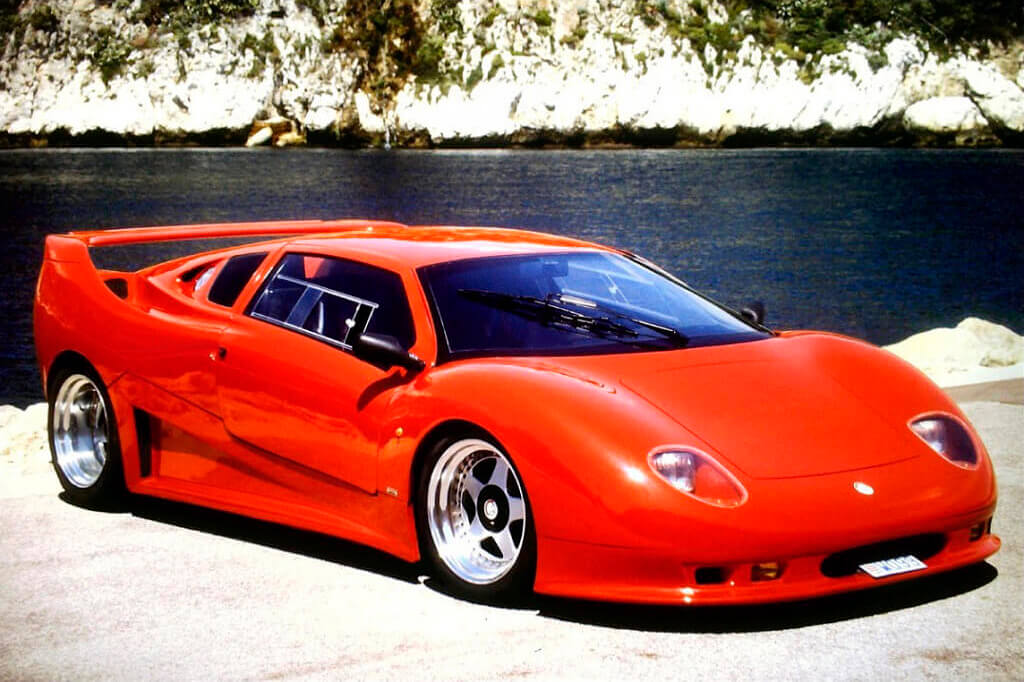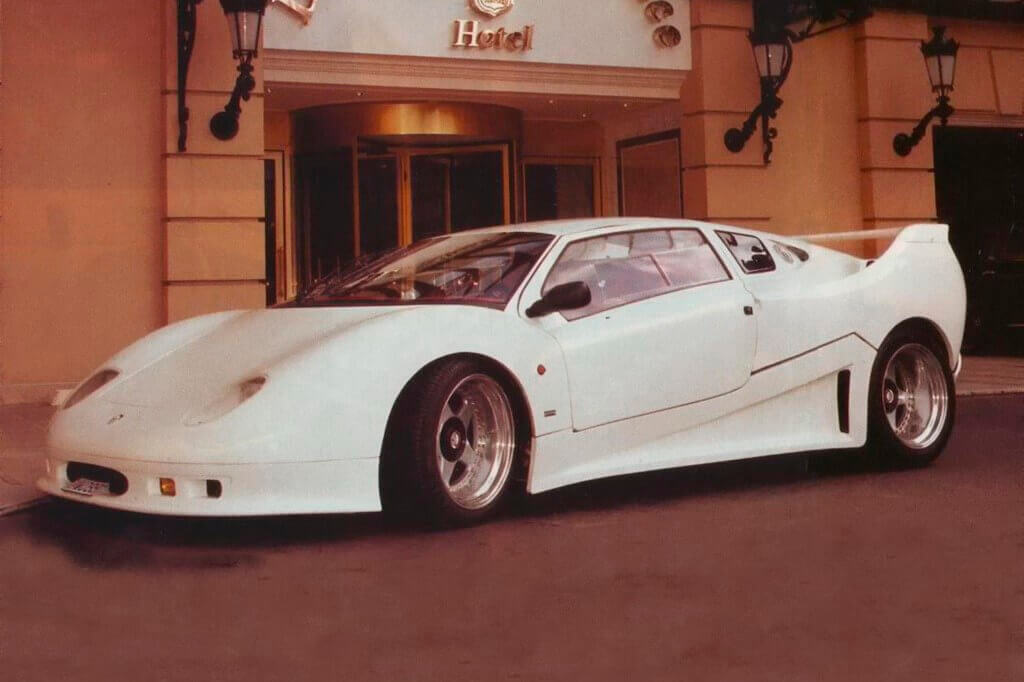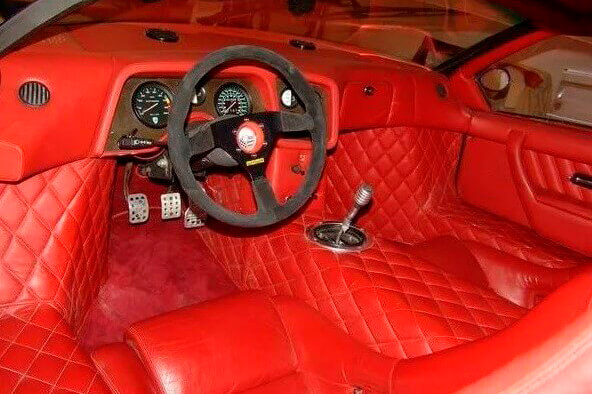MCA Centenaire
| Successor: |
|---|
Description
MCA Centenaire is the first sports car of the company, prepared in 1989 for the 100th anniversary (in honor of this event the car is named) of the National Automobile Club of Monaco, which was patronized by Prince Rainier III himself (the organizer of the Monte Carlo Rally and the F-1 Grand Prix in Monaco).
With hand-built construction and the use of Kevlar and carbon fiber, the MCA Centenaire was worth half a million US dollars.
Story
The project was overseen and directed by aeronautical engineer Carlo Citi, who spawned many racing cars that were often successful. Chiti had considerable experience, so much so that he designed several Formula 1 Ferraris that won the World Championship, and for several years was the technical director of Alfa Romeo's racing department, to whom he guaranteed several World Sports Prototype Championships.
It was originally planned to build 100 examples, but interest from buyers was much less, and in the end only five were built: one of these models belonged to Prince Ranieri, one was painted white and transferred to Lamborghini under an engine supply contract, one was red , one in black and two in blue. One of the blue ones had a removable hard top (like a targa) and had no rear fender, and was also named Beau Rivage, after the famous hotel in Monte Carlo.
In 1993, the brand got a new owner, Alexander Mingrelia. The car became known as "MIG Tako M 100". “MIG is an acronym for Mingrelia and Georgia. This is just one of the versions, as it was in fact, very interesting. There was information that Fulvio Ballabio in 1993, together with a new partner, concluded an agreement with a defense plant in Tbilisi, where parts for MIG fighters were produced in Soviet times. And under the brand of the newly formed company "Georgia Automotive Mig Tako", it was planned to start production of MIG supercars on the premises of the defense enterprise, as well as to launch the production of carbon components. In 1993, MIG sports cars tried to compete in the 24 Hours of Le Mans, but this did not end with success due to lack of money to finish the cars.
In 1995, the Aixam-Mega group of companies bought the Centenaire project. As a result, the Mega Monte Carlo appeared, which was presented at the 1996 Geneva Motor Show.
Engine
A Lamborghini engine was used as the power plant, for which Fulvio turned to the president of Lamborghini (which at that time were under the ownership of the Chrysler concern), so that they would allow the use of a 5-liter V12 with 455 hp. from the Countach 5000QV. This was the only time Lamborghini gave permission to someone to use their engines. For which they demanded one model in their museum.
Transmission
Torque was transmitted to the rear wheels via a 5-speed manual gearbox. The maximum speed was declared 350 kph, but in reality it was 305 kph.
Chassis
The highlight of the sports car was the frame and body. In total, it took 5 years of design and development to get a frame that would guarantee the required rigidity for the new engine. For the construction of the frame, it was decided to use Kevlar and carbon fiber with a honeycomb structure, such as a monocoque (it was the world's first car made entirely of this material for public roads). We also had to create an appropriate suspension, for which we decided to use a typical design from F1 cars of the push-rod type with an anti-roll bar.
Interior
Inside, the car had a quilted leather interior, bucket seats and air conditioning.
Sources
Specification
| Bodywork | |
|---|---|
| Years of production |
1990-1992
|
| Produced (pcs.) |
5
|
| Body type |
купе
|
| Number of doors |
2
|
| Number of places |
2
|
| Engine | |
|---|---|
| Engine type |
бензиновый
|
| Engine location |
центральное, продольное
|
| Engine model |
Lamborghini V12
|
| Cylinders |
V12
|
| V-angle |
60°
|
| Capacity (cc) |
5167
|
| Power output (hp / kW /) |
455 /
335 /
|
| at rpm |
7000
|
| Torque (N·m) |
500
|
| at rpm |
5200
|
| Bore (mm) |
85,5
|
| Stroke (mm) |
75,0
|
| Compression |
9,5
|
| Number of valves |
4/48
|
| Valvetrain |
DOHC
|
| Block material |
алюминиевый сплав
|
| Fuel system |
карбюратор
|
| Fuel system model |
Weber
|
| Turbocharger |
—
|
| Specific | |
|---|---|
| Specific output (hp/litre) |
88,06
|
| Specific output (hp/tonne) |
425,23
|
| Specific output (kg/hp) |
2,35
|
| Specific torque (N·m/litre) |
96,77
|
| Specific torque (N·m/tonne) |
467,29
|
| Transmission | |
|---|---|
| Driven wheels |
задний
|
| Clutch |
однодисковое
|
| Gearbox |
механическая
|
| Number of speeds |
5
|
| Final drive ratio |
4,090
|
| First gear ratio |
2,232
|
| Second gear ratio |
1,625
|
| Third gear ratio |
1,088
|
| Fourth gear ratio |
0,858
|
| Fifth gear ratio |
0,707
|
| Suspension | |
|---|---|
| Front suspension |
push-rod
|
| Rear suspension |
push-rod
|
| Elastic elements in front |
пружины
|
| Elastic elements in rear |
пружины
|
| Front anti-roll bar | |
| Rear anti-roll bar | |
| Tire brand |
Pirelli P Zero
|
| Tyres front |
245/45 R17
|
| Tyres rear |
335/35 R17
|
| Steering | |
|---|---|
| Steering type |
шестерня-рейка
|
| Brakes specs | |
|---|---|
| Brakes front |
дисковые вентилируемые
|
| Brakes rear |
дисковые вентилируемые
|
| Anti-lock braking system |
да
|
| Dimensions and weight | |
|---|---|
| Body |
монокок с панелями
|
| Body material |
углеволокно, кевлар
|
| Length (mm) |
4025
|
| Width (mm) |
2020
|
| Height (mm) |
1120
|
| Wheelbase (mm) |
2520
|
| Front track (mm) |
1560
|
| Rear track (mm) |
1600
|
| Ground clearance (mm) |
120
|
| Curb weight (kg) |
1070
|
| Performance specs | |
|---|---|
| Fuel tank capacity (l) |
120
|
| Fuel type |
бензин
|
| Dynamic specs | |
|---|---|
| Acceleration 0-100 kph (s) |
4,7
|
| Top speed (kph) |
305
|
|---|---|
| Top speed (mph) |
189
|
| Tags: | |
|---|---|
| Type: | |
| Brand: | |
| Country: |



